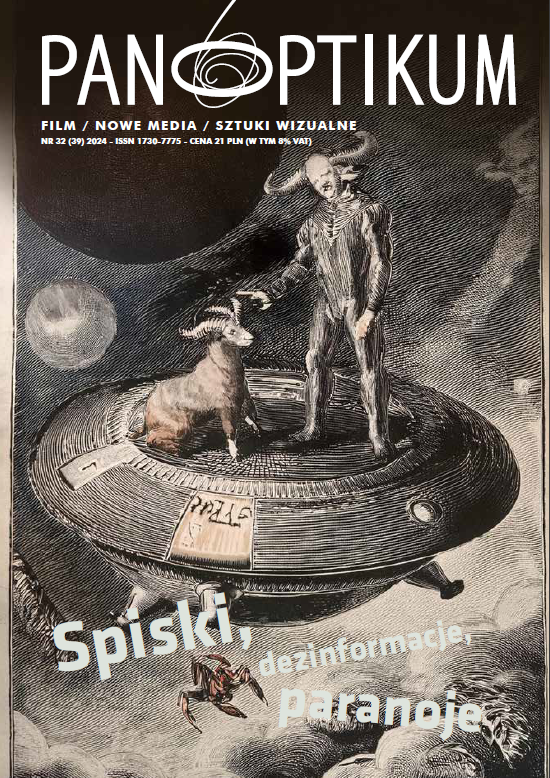Fenomen „filmów z żółtymi napisami” – rekonesans
DOI:
https://doi.org/10.26881/pan.2024.32.07Słowa kluczowe:
dokumenty spiskowe, wiedza stygmatyzowana, teorie spiskowe, pseudonaukaAbstrakt
Conspiracy documentaries have a significant impact on dissemination of alternative beliefs, with movies like Loose Change (2005) and Plandemic: The Hidden Agenda Behind Covid-19 (2020) garnering millions of views online. This article offers a cross-cutting analysis of this phenomena, connecting them to Michael Barkun’s concept of stigmatized knowledge, that encompasses ideas related to conspiracy theories, pseudoscience and esotericism. The study discusses the anti-establishment narratives commonly employed in rhetorical strategies of such movies and the ways in which different stigmatized ideas migrate and converge in contemporary film culture – both on a textual and contextual level.
Downloads
Bibliografia
Adamczyk, A. (2018). 7 faktów o piramidach, o których milczą… filmy z żółtymi napisami. kwantowo.pl/2018/06/19/7-faktow-o-piramidach/ (dostęp: 6.09.2024).
Arnold, G. (2008). Conspiracy Theory in Film, Television and Politics. London: Praeger.
Aupers, S., de Wildt, L. (2021). Down the Rabbit Hole: Heterodox Science on the Internet, [w:] D. Houtman, S. Aupers, R. Laermans (red.), Science Under Siege Contesting the Secular Religion of Scientism. Cham: Palgrave Macmillan.
Barkun, M. (2013). A Culture of Conspiracy Apocalyptic Visions in Contemporary America. Berkeley–Los Angeles–London: University of California Press.
Bennato, D. (2017). The Shift From Public Science Communication to Public Relations. The Vaxxed Case. „Journal of Science Communication”, Vol. 16, No. 2.
Butter, M. (2010). From Alerting the World to Stabilizing its Own Community: The Shifting Cultural Work of the Loose Change Films. „Canadian Review of American Studies”, Vol. 40, No. 1.
Butter, M. (2020). Conspiracy Theories in Films and Television Shows, [w:] P. Knight, M. Butter (red.), Routledge Handbook of Conspiracy Theories. London–New York: Routledge.
Butter, M., Knight, P. (2019). The History of Conspiracy Theory Research, [w:] J. Uscinski (red.), Conspiracy Theories and the People Who Believe Them. New York: Oxford University Press.
Cholewa, M. (2023). 15 lat w króliczej norze – Brent Lee opowiada, jak to jest żyć w świecie teorii spiskowych. demagog.org.pl/analizy_i_raporty/15-lat-w-kroliczej-norze-brent-lee- opowiada-jak-to-jest-zyc-w-swiecie-teorii-spiskowych/ (dostęp: 6.09.2024).
Czech, F. (2015). Spiskowe narracje i metanarracje. Kraków: Nomos.
Edgerton, G. (1982). Charles E. Sellier, Jr. and Sunn Classic Pictures. „Journal of Popular Film and Television”, Vol. 10, No. 3.
Elsaesser, T. (1998). Digital Cinema: Delivery, Event, Time, [w:] T. Elsaesser, K. Hoffman (red.), Cinema Futures: Cain, Abel or Cable. Amsterdam: Amsterdam University Press.
Hoops, R. (15.02.1983). Film Traces 33 Years of CIA’s ‘Secret History’. „Minnesota Daily”.
Juszkiewicz, W. (2020). Dobra Rozmowa | Gość: Krzysztof Słupianek – Festiwal Filmów Kontrowersyjnych. facebook.com/transferdobratv/videos/1151026248591772/ (dostęp: 12.09.2024).
Lis, P. (1979). Wspomnienia z przyszłości jako przykład filmu pseudonaukowego. „Filmowa Informacja i Komunikacja”, nr 1.
Mering, P. (2023). YouTube nie musi utrzymywać filmów z żółtymi napisami. Treści antyszczepionkowe nie są bezwzględnie chronione wolnością słowa. bezprawnik.pl/youtube- nie-musi-utrzymywac-tresci-antyszczepionkowych (dostęp: 6.09.2024).
naEKRANIE.pl (2023). YouTube przestanie rekomendować filmy z teoriami spiskowymi. naekranie.pl/aktualnosci/youtube-przestanie-rekomendowac-filmy-z-teoriami- sposkowymi-3943692 (dostęp: 6.09.2024).
Naczelna Izba Lekarska (2017). Szczepienia. NIL, GIS i NIZP – PZH piszą do Prezesa TVN. nil.org.pl/aktualnosci/738-szczepienia-nil-gis-i-nizp-pzh-pisza-do-prezesa-tvn (dostęp: 15.12.2024).
Pedersen, P. (2013). The Never-Ending Disaster: 9/11 Conspiracy Theory and the Integration of Activist Documentary On Video Websites. „Film and Media Studies”, Vol. 6, No. 1.
Pratt, R. (2002). Projecting Paranoia: Conspiratorial Visions in American Film. Kansas: University Press of Kansas.
Price, R. (2021). Video-Streaming Site Gaia’s Office Is Full of Conspiracy Theories. businessinsider.com/i spiracy-theories-2021-1 (dostęp: 13.09.2024).
Przylipiak, M. (2000). Poetyka kina dokumentalnego. Gdańsk: Wydawnictwo Uniwersytetu Gdańskiego.
Ramstedt, T. (2018). Knowledge and Identity within the Finnish Fringe-Knowledge Scene. Abo: Abo Akademi University Press.
Sales, N. (2006). Click Here for Conspiracy. vanityfair.com/news/2006/08/loosechange200608 (dostęp: 6.09.2024).
Sørenssen, B. (2014). Digital Diffusion of Delusions: A World Wide Web of Conspiracy Documentaries, [w:] K. Nash, C. Hight, C. Summerhayes (red.), New Documentary Ecologies. Emerging Platforms, Practices and Discourses. London: Palgrave Macmillan.
Stone, N. (2019). Political Goals versus Commercial Goals: Emile de Antonio’s Rush to Judgment on the Market. „Media Industries”, Vol. 6, No. 2.
Stuart, S. (24.10.1984). John Birch Rolls Higher, Leader Says. „The Des Moines Register”.
Voas, D., Ward, C. (2011). The Emergence of Conspirituality. „Journal of Contemporary Religion”, Vol. 26, No. 1.
Walker, J. (2019). What We Mean When We Say “Conspiracy Theory”, [w:] J. Uscinski (red.), Conspiracy Theories and the People Who Believe Them. New York: Oxford University Press.
YouTube Team (2019). Continuing Our Work To Improve Recommendations On YouTube. blog.youtube/news-and-events/continuing-our-work-to-improve/ (dostęp: 14.09.2024).

 Uniwersyteckie Czasopisma Naukowe
Uniwersyteckie Czasopisma Naukowe









